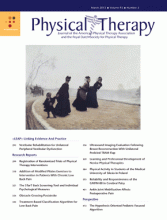Abstract
Background A muscle-sparing (MS) procedure using a full-width pedicled transverse rectus abdominis (RA) myocutaneous (TRAM) flap was developed to reduce abdominal morbidities after breast reconstruction. However, the effects of this procedure on the morphology of the remnant RA muscle and other abdominal muscles remain unclear.
Objective Ultrasound imaging was used to evaluate the morphology of the remnant RA muscle and other abdominal muscles in women with the MS pedicled TRAM flap procedure.
Design A case-control, cross-sectional design was used.
Methods Thirty-four women with an MS unilateral pedicled TRAM flap procedure after mastectomy (TRAM group) and 25 women who were healthy and matched for age (control group) participated. The curl-up test measured trunk flexor muscle strength. Ultrasound imaging measured the thickness of all abdominal muscles in all participants and the cross-sectional area of the RA muscle at rest and in an isometric position with the head raised in women in the TRAM group. Acoustic echogenicity and border visibility assessed the tissue composition of the remnant RA muscle.
Results Trunk flexor muscle strength was weaker in the TRAM group than in the control group. Compared with the remnant RA muscle in the contracted state, the remnant RA muscle in the relaxed state was thinner and had a smaller cross-sectional area. The remnant RA muscle in the relaxed state also was thinner, more echoic, and less visible than its contralateral counterpart. No differences in the thickness of the other abdominal muscles were found between the sides. The abdominal muscles in the TRAM group were smaller than those in the control group.
Limitation Because a prospective, longitudinal design was not used, a definite cause-effect relationship could not be determined.
Conclusions In women with an MS unilateral pedicled TRAM flap procedure, the remnant RA muscle retains its ability to change in size during contraction, albeit at reduced levels. Muscular atrophy occurs in other ipsilateral and contralateral abdominal muscles as well as the remnant RA muscle. Postoperative immobilization is the most likely cause of generalized weakness of the abdominal musculature.
Footnotes
Ms Liaw, Dr M-F. Hou, and Dr Hsu provided concept/idea/research design. Ms Liaw and Dr Hsu provided writing and fund procurement. Ms Liaw and Dr Guo provided data collection. Ms Liaw, Dr Y-Y. Hou, and Dr Hsu provided data analysis. Ms Liaw provided project management. Dr Lin provided study participants. Dr Guo provided facilities/equipment. Dr Lin, Dr Guo, and Dr Y-Y. Hou provided consultation (including review of manuscript before submission). The authors thank all of the patients and volunteers who were healthy for participating in this study.
This study was approved by the Institutional Review Board of Kaohsiung Medical University Chung-Ho Memorial Hospital, Kaohsiung, Taiwan.
This study was supported by grants from the National Science Council (NSC 98-2314-B-037-008-MY2) and Kaohsiung Medical University (KMU-Q098023) in Taiwan.
- Received February 15, 2012.
- Accepted October 9, 2012.












